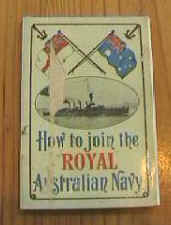|
In June 1912, a third destroyer, HMAS
Warrego was commissioned at Sydney and in 1913 the battle cruiser,
HMAS Australia and the light cruisers, HMA Ships Melbourne and Sydney
arrived in Australian waters. On the 4 October 1913, the Australian
Fleet entered Sydney harbour for the first time and in October of the
same year formal control of these units passed to the Commonwealth
Naval Board. Thus, direct Imperial control came to a conclusion.
During the same period the Royal Australian Naval College for the
training of officers was opened at Geelong, Victoria. This facility
was subsequently moved to Jervis Bay in 1915.
 |
At the outbreak of hostilities in 1914,
the Australian Fleet comprised a battle cruiser, six light cruisers,
six destroyers, two submarines and numerous support and ancillary
craft. The ships and men of the RAN operated as an
integral part of
the Royal Navy and served in all operational areas.
The Australian
Naval and Military Expeditionary Force carried in HMAS Berrima and
supported by units of the Australian Fleet captured German New Guinea
colonies in Australia's only national joint warfare operation to date.
The total number serving in the Permanent Naval Forces at the outbreak
of hostilities was 3800 all ranks. At the close of hostilities, 5263
personnel were serving. The Reserves provided a further 76 officers
and 2380 for home service, and 51 officers and 1775 ratings (sailors)
for service overseas.
|
|
The Royal Australian Navy's first task
was to protect Australia's ports, shipping and trade routes. As part
of securing Australia's maritime frontiers the RAN took part in the
first amphibious assault of the war when it played a major role in the
capture of the German colonies in the Pacific. After this operation
the ships of the RAN began the vital role of convoy escort.
It was
whilst escorting a convoy that the light cruiser HMAS SYDNEY was
detached to investigate the sighting of a strange warship. This ship
turned out to be the German light cruiser EMDEN. In the ensuing battle
SYDNEY destroyed the EMDEN and thus won the RAN's first battle.
|
 |
The RAN also played a supporting role in the Gallipoli campaign. HMAS
AE2 became the first allied warship to penetrate the Dardanelles, but
was eventually sunk by the Turkish navy in the Sea of Mamora. On the
peninsular the
RAN Bridging Train
provided vital service to the troops
as well as being the last Australians to leave Gallipoli.
The submarines AE1 and AE2 were the
only losses suffered by the RAN during this conflict. The first named
was lost with all hands off New Britain on the 14 September 1914, and
AE2 was scuttled by her crew in the Sea of Marmora on the 30 April
1915, after she had forced a passage through the dangerous waters of
the Dardanelles in support of the Gallipoli campaign.
With the cessation of hostilities and
the signing of the Armistice in 1918, a world-wide period of naval
retrenchment began, while subsequent disarmament conferences,
culminating in the Washington Treaty of 1922 brought drastic changes
to naval planning. Under the terms of the treaty, the battle cruiser
AUSTRALIA was scuttled off Sydney Heads in 1924. However, additions to
the battle order of the early post-war RAN included six submarines,
five destroyers, an additional destroyer and a number of sloops. All
these vessels were acquired from the Royal Navy.
In 1924 it was decided to purchase two
10 000 ton cruisers, two additional submarines and a further decision
was made to build a seaplane carrier at Cockatoo Dockyard, Sydney.
HMAS MORESBY was acquired on loan from the Royal Navy in 1925 for
surveying duties. The two cruisers commissioned as HMA Ships AUSTRALIA
and CANBERRA in 1928, and in the following year the submarines OXLEY
and OTWAY reached Australian waters.
-
The seaplane carrier commissioned
as HMAS ALBATROSS at Sydney in 1929.
In the early thirties, lack of funds
forced many economies in naval activity, one being the transfer of the
Naval College from Jervis Bay to Flinders Naval Depot in Victoria.
Strength of the RAN fell to 3117 personnel plus 131 members of the
Naval Auxiliary Services. In 1932 the strength of the Reserves stood
at 5446. At about this time, the submarines OXLEY and OTWAY reverted
to the Royal Navy.
In 1933, the RAN added 5 additional
destroyers to the Fleet to replace the ageing vessels that were at
that time due for scrapping. These vessels (which later became famous
during World War II as the 'Scrap Iron Flotilla') were not new, like
their predecessors they were built during World War 1. In the
remaining years of peace, three light cruisers were added to the
Fleet, ALBATROSS was transferred to the Royal Navy and two additional
sloops were constructed in Sydney.
During the inter-war years the fortunes
of the RAN fluctuated and reflected the general economic and social
trends. The monotony of peace-time exercises was only broken by a
punitive expedition to the Solomon Islands in 1927
In 1939 the men of the RAN once again
answered their nation's call. The role of the RAN during the Second
World War was much as it was in the First, securing Australia's sea
lines of communication and assisting Allied naval forces.
At the onset of war in 1939, the RAN
numbered two heavy cruisers, four light cruisers, five destroyers,
three sloops and a variety of support and ancillary craft. During the
27 months that ensued from the declaration of war against Germany and
the Japanese attack on the American Pacific Fleet at Pearl Harbour,
units of the RAN were engaged in operations against the enemy as far
afield as the North, West and South Atlantic, the Caribbean, the
Mediterranean, the Indian Ocean, Persian Gulf and Red Sea.
The RAN distinguished itself in the Mediterranean through the exploits
of the Scrap Iron Flotilla and the cruisers, most notably by HMAS
SYDNEY with her destruction of the Italian cruiser BARTOLOMEO
COLLEONI. Unfortunately, SYDNEY was later to be lost with all hands.
A new dimension was added when war broke out in the Pacific in
December 1941 with the Japanese attacking Pearl Harbor. Australia,
herself come under threat of direct attack and the ships of the RAN
formed Australia's first line of defence. With Allied navies the RAN
took part in the battles of Java Sea, Sunda Strait, Coral Sea, Savo
Island and Lingayen Gulf. The road to Tokyo was to cost the RAN dearly
with the heaviest losses resulting from the sinking of the cruisers
PERTH and CANBERRA.
The total number of personnel serving
in the Permanent Forces at the outbreak of war was 5010. By July 1945,
the heavy demands of war had increased this number to nearly 37000 all
ranks. Ship losses and personnel casualties suffered by the RAN during
the conflict were substantial. The heavy cruiser CANBERRA, the light
cruisers SYDNEY (sunk with the loss of all hands) and PERTH the
destroyers NESTER, VAMPIRE, VOYAGER and WATERHEN, the sloops
PARRAMATTA and YARRA and nearly thirty other RAN vessels of all types
were lost as a result of wartime service. Nearly 2170 members of the
RAN lost their lives during World War II.
The Royal Australian Navy paid a high
price indeed, in terms of sacrifice, in the quest for victory and a
lasting peace.
Since the end of the Second World War,
units of the RAN have engaged in operations in the Korean Theatre,
during the Indonesian Confrontation, the Vietnam War and more recently
the Gulf War. The Royal Australian Navy plays an active role in
supporting United Nations peacekeeping operations throughout the
world. Members of the Navy have been deployed in recent United Nations
missions to Somalia, Cambodia Rwanda and East Timor.
|